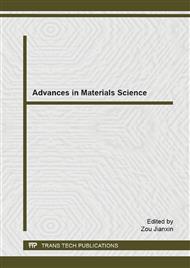[1]
M. Humenik Jr, N.M. Parikh, Cermets: I, Fundamental Concepts Related to Micro-structure and Physical Properties of Cermet Systems , J. Am. Ceram. Soc. 39 (1956) 60-63.
DOI: 10.1111/j.1151-2916.1956.tb15624.x
Google Scholar
[2]
S. Zhang, Titanium carbonitride-based cermets, processes and properties, Mater. Sci. Eng. A163 (1993) 141-148.
Google Scholar
[3]
P. Ettmayer, H. Kolaska, W. Lengauer, K. Dreyer, Ti(C, N) cermets — Metallurgy and properties, Int. J. Refract. Met. Hard Mater. 13 (1995) 343-351.
DOI: 10.1016/0263-4368(95)00027-g
Google Scholar
[4]
F. Qi, S. Kang, A study on microstructural changes in Ti(CN)–NbC–Ni cermets, Mater. Sci. Eng. A251(1998) 276–285.
DOI: 10.1016/s0921-5093(98)00609-1
Google Scholar
[5]
A.S. -Yong, K. S. -Won, S. Kang , Microstructure of Ti(C, N)-WC-NbC-Ni cermets, J. Am. Ceram. Soc. 84 (2001) 843-849.
DOI: 10.1111/j.1151-2916.2001.tb00750.x
Google Scholar
[6]
W. Jun, L. Ying, F. Yan, Y. Jinwen, T. Mingjing, Effect of NbC on the microstructure and sinterability of Ti(C0. 7, N0. 3)-based cermets, Int. J. Refract. Met. Hard Mater. 27 (2009) 549–551.
Google Scholar
[7]
S. Kim, J. -M. Zuo, S. Kang, Effect of WC or NbC addition on lattice parameter of surrounding structure in Ti(C0. 7N0. 3)–Ni cermets investigated by TEM/CBED, J. Euro. Ceram. Soc. 30 (2010) 2131-2138.
DOI: 10.1016/j.jeurceramsoc.2010.03.006
Google Scholar
[8]
M. Ueki, Studies on the Relation between Microstructures and Cutting Performance of Titanium Carbide Based Cermet Containing Nitrogen, J. Jpn. Soc. Powder Powder Metallurgy, 40 (1993) 743-750.
DOI: 10.2497/jjspm.40.743
Google Scholar
[9]
M. Ueki, T. Saito, T. Saito, K. Kitamura, H. Suzuki, Properties of TiC-TiN-Mo2C-Ni Alloy Affected Mainly by Additional Tantalum or Tungusten Carbide, J. Jpn. Soc. Powder Powder Metallurgy, 35 (1985) 27-32.
DOI: 10.2497/jjspm.35.27
Google Scholar
[10]
H. Suzuki, K. Hayashi, T. Yamamoto, Effects of a Small Amount of Additional Carbides on High-Temperature Strength of TiC-Mo2C-Ni Cermets, J. Jpn. Soc. Powder Powder Metallurgy, 26 (1979) 22-26.
DOI: 10.2497/jjspm.26.22
Google Scholar
[11]
H. Suzuki, K. Hayashi, O. Terada, Effects of Addition of Carbides on the Strength of TiC-Mo2C-Ni(Co) Alloys, J. Jpn. Soc. Powder Powder Metallurgy, 25 (1978) 132-135.
DOI: 10.2497/jjspm.25.132
Google Scholar
[12]
E. Ohtsuki, H. Fulita, T. Kito, Y. Masuda, Fracture Toughness and Limiting Strength of Cermets, J.Japan Inst.Metals, 47 (1983) 568-574.
Google Scholar
[13]
K. Niihara, R. Morena, D.P.H. Hasselman, Evaluation of KIC of brittle solids by the indentation method with low crack-to-indent ratios, J. Mater. Sci. Lett. 1 (1982) 13-16.
DOI: 10.1007/bf00724706
Google Scholar
[14]
T. Ogura, T. Shoji, A. Sasaki, O. Terada, H. Hayashi, Koushitsuzairyou no hanaijinsei ni oyobosu ketugousouryou no eikyou. Abs. Aut. Meet. J. Soc. Powde Powder Met. (2009) 132.
Google Scholar


